The Fall of Crypto: Explained
You may have seen recent headlines referring to a now defunct company called FTX appearing alongside terms such as “fraud,” or “collapsed empire.” You may have also glanced at the subheadlines hoping to glean some cursory understanding of what had happened and the potential impact on you and your family. Below you will find a review of the collapse of crypto.
FTX was a platform that allowed people to buy and sell digital assets. It was a digital currency exchange in which investors could trade in cryptocurrencies without having to set up a crypto wallet. Many crypto investors used FTX in hopes of earning higher yields than those given at traditional banks. FTX was, until recently, the world’s fifth largest exchange. Sam Bankman-Fried, the founder of FTX, is the public face of the company. In addition to creating FTX, Sam Bankman-Fried also launched a closely affiliated trading firm known as Alameda Research. Cryptocurrencies experienced a period of strong growth in value from 2016-2018, but became more volatile since 2018 with periods of busts and then recovery. In 2021, many platforms began to shut down as the broader crypto industry declined, but FTX continued profiting and began buying their competitors. FTX created its own digital token known as FTT that acted like a stock. However, it was difficult to track how many tokens had been created. On the surface, it appeared as if the platform was thriving. But, at least $1 billion in customer funds was missing.
FTX’s sister investing firm, Alameda Research, took a significant position in FTT tokens in circulation as they were used to take out loans. In other words, Alameda used funds provided by FTX to run its trading business.This was dangerous for Alameda, since if FTT fell below a certain level, the lenders would call in their loans forcing FTT to sell their positions and return the money owed. In early November, it was reported that Alameda had two-fifths of its balance sheet in FTT, which caused panic among customers worried that this would lead to exchange problems. As a result, Binance, a competitor of FTX, sold all of its FTT tokens, creating a large price drop. Many customers removed their assets from FTX, until FTX stopped allowing customers to take money out. Anonymous sources stated that 8 billion dollars were owed by the crypto company. This is believed to have been a result of Alameda using FTX customer funds for trading. Bankman-Fried needed to raise the amount of money owed within the next two weeks.
Soon after these reports had been confirmed, $400 million dollars of assets were moved out of the FTX accounts. Bankman-Fried thought that these transfers were an internal mislabeling issue. The platform does not have a paper trail that indicates the money that FTX had or where the money went. Typically, businesses have balance sheets that provide information on the company’s assets. Bankman-Fried has acknowledged that FTX had very poor accounting practices, which compounded some of its issues.
The company has been slowly recovering the money that had been lost. However, only a fraction of the amount has been received. Bankman-Fried searched for a way to keep his company from sinking, so when Zhao, a former investor of FTX, discussed having Binance purchase the company, a deal was made. However, Binance backed out of the deal when they learned that FTX had mismanaged their user funds and information.
On Nov. 11, Bankman-Fried stepped down as CEO of FTX and the companies that he resided over filed for Chapter 11 bankruptcy. The Securities and Exchange Commission and the Department of Justice are reported to be investigating the cryptocurrency company and attempting to recover as much investor money as possible. However, many investors fear that they may have lost all of their crypto investments traded on FTX. As a result of the collapse of FTX, federal regulators will be taking enforcement actions in the future and investors will approach digital assets with more caution.
BY MADELEINE HODGES
